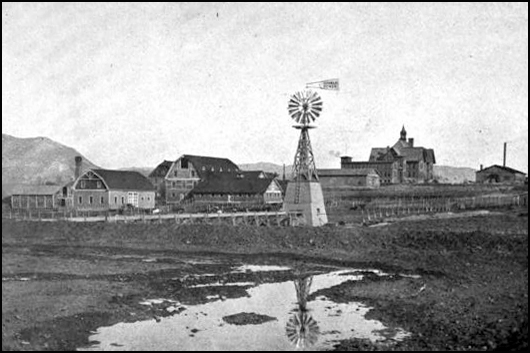Annals of MSC: 1900-1918
Note3
The 1900-1901 MSC Catalog listed registrations of 3 graduate students, 71 college-level students, and 95 preparatory students. MSC employed 15 college faculty and 7 experiment station staff. Instruction was offered in the Collegiate Department for eight four-year course plans leading to degrees in: General Science, Agriculture, Biology, Chemistry, Mechanical Engineering, Electrical Engineering and Civil Engineering. The Preparatory Department offered a three-year course plan, the Business Department offered a few one-year courses, The Art Department and Music Department each offered a four-year course plan.
In September, 1904, James Reid resigned, and James Hamilton was appointed to the presidency. It was President Hamilton (3rd President 1904-1919) who coined a motto – “Education for Efficiency” to replace the original ”Culture and Skills”. Hamilton’s motto lasted until the 1990s when it was replaced with “Mountains and Minds”.

MSC from the west in 1906
During James Hamilton’s presidency, the size of the College grew from 356 total students in 1904 to 519 students in the degree curricula, plus 359 in short course and special music programs, in 1918. The photo of MSC in 1906 showing a windmill, barns, and Montana Hall in the distance, illustrates the College emphasis on agricultural science. As the college grew, additional space was required. A gymnasium was constructed and fields were laid out for athletics and military drill south of Montana Hall. Between 1910 and 1912, the College opened Hamilton Hall, which provided room and board for women, and the spacious Linfield Hall. MSC also built a heating plant, various laboratories, additions, greenhouses, and barns.6
The cost of attending MSU was quite affordable in the early 20th century. The 1900-1901 MSC Catalog estimated that a student’s total expenses for a year would be $175 ($5,100 when inflation adjusted to 2017 dollars). The basic tuition and fees were $12 per course per year and some courses required additional fees, mostly for supplies and equipment.
MSC provided no living accommodations for students. Room and board were available in the community for about $15 per month. In the 1910-1911 catalog, it was estimated that a student’s total expenses for a year, including tuition, books, room, board and incidental expenses was $350 ($9,000 when inflation adjusted to 2017).
A Woman’s Dormitory, was completed by 1911. There was no men’s dormitory connected with the college but about twenty young men could be accommodated at the “club on the campus.” Students who did not live in the dormitory or at the club could find room and board with private families. A list of approved places with prices and accommodations was kept in the president’s office. A committee of students met all trains at the depot (E. Tamarack & Front St.) on registration days, and at other times on request, and aided in finding satisfactory locations.
After a bitter political fight over a proposal to consolidate the four institutions (the University in Missoula, the College in Bozeman, the Normal College in Dillon, and the School of Mines in Butte), a compromise was reached. “in 1913 the four institutions were combined into the University of Montana under the executive control of an officer whose title was Chancellor. In October, 1915, Edward C. Elliott was appointed the first Chancellor of the University of Montana. MSC President Hamilton submitted a letter of resignation in 1915, ostensibly ... to provide flexibility in readjustments under the chancellor system ... but ... he was asked to continue, which he did. ... The initiation of the chancellor system caused several changes ... The University ... was forbidden to give courses in engineering ... the course in pharmacy was moved from the College to the University.”9
While the state was engaged in a political fight over education, World War I (1914-1918) broke out in Europe and the U.S. began to prepare for possible involvement by activating the draft. Montanans were enthusiastic supporters of war preparations. Perhaps inspired by the unifying spirit of the times, MSC students during 1916 designed and constructed the “M” on the southwest aspect of Mount Baldy. Young men flocked to enlist and in April, 1917, the school decreed that seniors enlisting before the close of the school year could still be eligible for their degrees. Many faculty members left for work related to the war.12 The U.S. Military recognized the utility of engineering and technology and sent trainees to campus. In the autumn of 1918, the Student Army Training Corps was on campus, with 310 men housed in hastily constructed barracks, buildings that were used for many decades. Mathematics courses were held in the barracks until the early 1970s. The war made the campus realize that the knowledge it imparted was a valuable service to the country as well as to the students and state.
Montana Governor Steward organized the Montana Council of Defense, which promoted ultra-patriotism to the extent of persuading the Chancellor to order that Montana colleges remove German-language books from the libraries and end German language instruction immediately.15 After the 1918-19 Catalog was published, the following printed announcement was inserted into the catalog by hand: In accordance with the order of the State Council of Defense there will be no instruction in German during the year 1918-1919. “An editorial in the Exponent on April 26, 1918, announced that the German department had shut its doors ... but thoughtfully suggested the continuing need for the German language, particularly in a college emphasizing science and technology.”18
In addition to the war, the flu pandemic of 1918-19 affected MSC. The pandemic took 21 million lives worldwide, including the lives of 675,000 Americans. In Montana, 5000 people, most between ages 18 and 45, died due to the flu.21 “The severity of the epidemic led to the virtual closing of the academic branch of the institution.”24 MSC cancelled football and basketball for 1918-19.27
Annals of MSC during Era 3
Next topic (National Events) in Era 2
Table of Contents
(Last revised: 2021-04-17)
